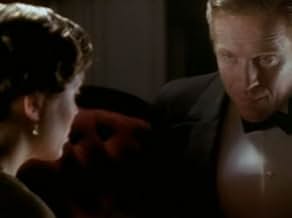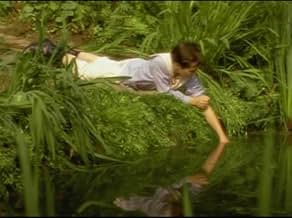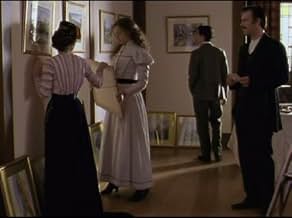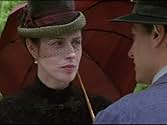Une chronique de la vie de trois générations de la famille britannique de la classe moyenne supérieure, les Forsytes, des années 1870 à 1920.Une chronique de la vie de trois générations de la famille britannique de la classe moyenne supérieure, les Forsytes, des années 1870 à 1920.Une chronique de la vie de trois générations de la famille britannique de la classe moyenne supérieure, les Forsytes, des années 1870 à 1920.
- Victoire aux 1 BAFTA Award
- 2 victoires et 4 nominations au total
Parcourir les épisodes
Avis à la une
This is the sequel to the previous year's mini series, The Forsyte Saga, based on John Galsworthy's novel. It continues on with the dramatic lives of the younger generation of Forsytes, namely the forbidden romance between Fleur and Jon. Fleur is the daughter of Soames Forsyte, and Jon the son of Soames's former wife, Irene. Once again scandal, secrets, and deception dominate the tale. Like its predecessor, this saga has beautiful English scenery, finely furnished country manors, and lovely period costumes.
The story is interesting, though I personally find Fleur not a sympathetic heroine at all but instead totally self absorbed, deceptive, and manipulative. Jon is much more appealing, a young man with a deep love and respect for his parents. From their first encounter at an art gallery, the lovely & spoiled Fleur has made up her mind to have Jon for herself. Naturally their ill advised love affair opens up all the old wounds between Soames and Irene. In addition to Fleur and Jon, there is a likable third party to the love triangle... Michael Mont, who also vies for Fleur's affections. Essentially the conniving Fleur uses poor Michael for her own selfish purposes.
Actually, the most compelling part of the story for me remains the unfolding lives of the older generation, Soames and Irene. Soames is now wed to the unfaithful French Annette, and Irene is happily married to Jolyon. Especially given the drama with their offspring, will Soames ever be rid of his obsession with Irene, the wife who never loved him and is now married to another?
The story is interesting, though I personally find Fleur not a sympathetic heroine at all but instead totally self absorbed, deceptive, and manipulative. Jon is much more appealing, a young man with a deep love and respect for his parents. From their first encounter at an art gallery, the lovely & spoiled Fleur has made up her mind to have Jon for herself. Naturally their ill advised love affair opens up all the old wounds between Soames and Irene. In addition to Fleur and Jon, there is a likable third party to the love triangle... Michael Mont, who also vies for Fleur's affections. Essentially the conniving Fleur uses poor Michael for her own selfish purposes.
Actually, the most compelling part of the story for me remains the unfolding lives of the older generation, Soames and Irene. Soames is now wed to the unfaithful French Annette, and Irene is happily married to Jolyon. Especially given the drama with their offspring, will Soames ever be rid of his obsession with Irene, the wife who never loved him and is now married to another?
The screenwriter has once again decided to rewrite the story. Read the book (actually books) to find out all the differences. For example, in the book the governess leaves on her own & refuses any extra pay, Young Jolyon is seen visiting her flat & the gossip starts - that's when Jolyon's wife and father first learn anything is going on. The changes go on and on. If you have ever seen the 1967 version, it would be hard to beat Eric Porter as Soames.
All I can say about this series is that it should of been called The Irene Forsyte Saga.
Comparisons between the 60s version of this splendid work and the latest one are difficult because they were both great. I have really enjoyed the last version especially as regards the performances of Damian Lewis and Gina McKee.
One previous contributor said that he found himself almost liking Soames which 'we were not supposed to do'. Is that right? Galsworthy intended The Forsytes to be representative of the upper middle class with some bad aspects - arrogance, lack of sentiment, conscious always of their respectability - but also with a positive side - sturdy, determined, ambitious, but ultimately concerned with ownership and property. Soames is an extreme example of his kind, to the extent that he regards people - especially his wife - as potential property. Irene, on the other hand, represents the new force which, along with the effects of WWI and the rise of the Welfare State, nationalisation etc will soon overthrow the old order.
Superficially at least, Soames is the villain. He appears to terrorise his wife, physically abuses her and more. However, is there another side to this? Irene marries him quite cynically for materialistic reasons. It's not merely a question of 'not loving' him. He positively makes her flesh creep right from the start. We are given the idea that she is forced to marry him by her stepmother and by her poverty. Force her?? As the story goes forward, we see that she is a strong character - no-one can force her to do anything. Her poverty? She has £50 per annum from her father. This might not seem a lot, but it was about what an artisan earned in a year at that time (on which he was expected to keep a family). Despite his treating her as property, Soames does love Irene in his way and he does try his best to give her what she wants. In return she is openly unfaithful to him, denies him children and even conjugal rights. As regards his bad treatment of her, she certainly returns the compliment in kind. She could be looked on as something of a vampire - she sucks the life force from Soames and old Jolyan and wantonly destroys the happiness of her friend June and Bossiney (though admittedly he goes along willingly). As regards her own son her hatred of Soames tempers her dislike of Fleur so even her son is badly affected by her force of character and neurosis.
I think Galsworthy, as well as writing a simple commentary on Edwardian and Victorian life was also trying to divide his readers into factions - the pro-Soames camp who like the old ways, and the pro-Irene (the 'new woman' camp) who wanted change.
Whatever, I have to congratulate Gina McKee. She carried off that complex character of Irene so well. Her enigmatic Mona Lisa smile, did it display goodness? Or the opposite? I'm still not sure
One previous contributor said that he found himself almost liking Soames which 'we were not supposed to do'. Is that right? Galsworthy intended The Forsytes to be representative of the upper middle class with some bad aspects - arrogance, lack of sentiment, conscious always of their respectability - but also with a positive side - sturdy, determined, ambitious, but ultimately concerned with ownership and property. Soames is an extreme example of his kind, to the extent that he regards people - especially his wife - as potential property. Irene, on the other hand, represents the new force which, along with the effects of WWI and the rise of the Welfare State, nationalisation etc will soon overthrow the old order.
Superficially at least, Soames is the villain. He appears to terrorise his wife, physically abuses her and more. However, is there another side to this? Irene marries him quite cynically for materialistic reasons. It's not merely a question of 'not loving' him. He positively makes her flesh creep right from the start. We are given the idea that she is forced to marry him by her stepmother and by her poverty. Force her?? As the story goes forward, we see that she is a strong character - no-one can force her to do anything. Her poverty? She has £50 per annum from her father. This might not seem a lot, but it was about what an artisan earned in a year at that time (on which he was expected to keep a family). Despite his treating her as property, Soames does love Irene in his way and he does try his best to give her what she wants. In return she is openly unfaithful to him, denies him children and even conjugal rights. As regards his bad treatment of her, she certainly returns the compliment in kind. She could be looked on as something of a vampire - she sucks the life force from Soames and old Jolyan and wantonly destroys the happiness of her friend June and Bossiney (though admittedly he goes along willingly). As regards her own son her hatred of Soames tempers her dislike of Fleur so even her son is badly affected by her force of character and neurosis.
I think Galsworthy, as well as writing a simple commentary on Edwardian and Victorian life was also trying to divide his readers into factions - the pro-Soames camp who like the old ways, and the pro-Irene (the 'new woman' camp) who wanted change.
Whatever, I have to congratulate Gina McKee. She carried off that complex character of Irene so well. Her enigmatic Mona Lisa smile, did it display goodness? Or the opposite? I'm still not sure
10ids
This second installment lives up to the expectations created by the first series and by the novel itself - To Let. We meet again, with much pleasure, the magnificent cast of the first series (D. Lewis as Soames stands out) and discover the choices that have been made to cast the 4 new main characters : Fleur and Jon Forsyte, Prosper Profound, and Michael Mont. I found the 4 of them to be nearly-ideally suited to their part. May be the actor playing Jon lacked a little bit of brilliance, but he showed a lot of sensibility and looked a lot like his "mother", Irene. The story unfolds with relentlessness but there are also many moving, or funny moments. The films is really faithful to the tone of Galdsworthy and is, all in all, a magnificent achievement. it is as good as the first series, and may be even better. At the end of the 4th episode, we are really sorry to have to wait for the next episodes of the saga, and the lives of Fleur and Michael Mont. Highly recommended to fans of British top quality literary drama.
Le saviez-vous
- AnecdotesThe series as it is shown on Amazon Prime divides Season One into eight of approximately 55 minute each, and Season Two into five episodes. Whereas, it was originally shown as six episodes for Season One, and four episodes in Season Two.
- Citations
Soames Forsyte: You know nothing about it. Your friendship with her was a sham!
June: Yes! She stole the love of my life, my future. I should hate her but the alternative was you. I cannot hate her. I can only wonder why she did not do it sooner.
- ConnexionsFeatured in The Best of Masterpiece Theatre (2007)
- Bandes originalesIrene's Song
(End titles music)
Music by Geoffrey Burgon
Lyrics by Jacqueline Kroft
Performed by Bryn Terfel
Meilleurs choix
Connectez-vous pour évaluer et suivre la liste de favoris afin de recevoir des recommandations personnalisées
- How many seasons does The Forsyte Saga have?Alimenté par Alexa
Détails
- Date de sortie
- Pays d’origine
- Sites officiels
- Langue
- Aussi connu sous le nom de
- La saga de los Forsyte
- Lieux de tournage
- Croxteth Hall, Muirhead Avenue East, West Derby, Liverpool, Merseyside, Angleterre, Royaume-Uni(James and Emily's home)
- Sociétés de production
- Voir plus de crédits d'entreprise sur IMDbPro
Contribuer à cette page
Suggérer une modification ou ajouter du contenu manquant

Lacune principale
What is the Brazilian Portuguese language plot outline for The Forsyte Saga (2002)?
Répondre






































